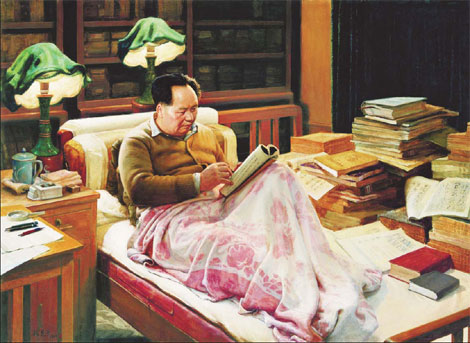In search of Mao
A new exhibition of 13 paintings of Chairman Mao by Wei Chuyu seeks the man behind the public image.
|
Searching the Truth, oil on canvas by veteran artist Wei Chuyu, shows Chairman Mao reading in bed surrounded by books. [China Daily] |
An exhibition of 13 paintings portraying the late Chairman Mao Zedong will open at the Sunbow Gallery at M50 in Shanghai on Saturday.
"These paintings depict Mao as a son, a student, a father, a man of the country, a soldier and a statesman. They are plain and simple, truthfully presenting the important turning points in Mao's life - which are also turning points in modern Chinese history," Cai Xiao, owner and artistic director of Sunbow Gallery, tells China Daily.
Cai who has called the exhibition Transvision, says, "I want to offer a different view of history and of Chairman Mao. I think this is the significance of Mr Wei's art - it provides a real contemporary view of Mao, a great person who founded New China."
Wei Chuyu, 65, a veteran artist with the Chinese Museum of Military History in Beijing, is the artist responsible for the oil paintings.
A graduate of the China Academy of Art in Hangzhou, Wei started to paint pictures of Mao during the "cultural revolution" (1966-76), when regular classes were disrupted. He produced propaganda posters, most of which bore images of Mao and his quotations.
"Some of the works were huge," Wei recalls. "A button in Mao's jacket could be two arms' length in diameter."
What he learned during this period was put to good use in 1993 when he became the designer for the commemorative stamps created to celebrate the centennial anniversary of the birth of Chairman Mao (1893-1976).
He spent the next six years creating Searching the Truth, which shows Chairman Mao reading in bed surrounded by books.
Wei did lots of research and talked to everyone he could find that lived and worked close to Mao, including Mao's nurse and bodyguards. He also visited Mao's bedroom, which had never been photographed and filmed.
"It was in the bedroom that I found my inspiration," Wei says. "In my view, the late chairman spent his whole life thinking about transforming people into what he deemed ideal," he explains.
He says that while Mao's ideal for a New China drew huge support during the war years, his new and ever-changing vision after 1949 did not agree with people's aspirations for a better life.
"That was where he went wrong because he infringed upon individual rights and interests," Wei says. "In my work, I want to highlight Mao's life-long pursuit for an 'ideal man'."
Cai says he was very impressed when he first saw Searching the Truth. Unlike the 1970s' propaganda posters, where Mao looked heroic, righteous and perfect, Cai says that Wei's great achievement with Searching the Truth was to paint "Chairman Mao as an ordinary human - a real person."
"I saw too much political pop art - the way they sneer at Chairman Mao made me sick," Cai tells China Daily. "I understand that it would require lots of courage to paint like that in the 1980s and 1990s, but now, these artists do it just to impress Western audiences and be famous - it's just cheap sensationalism."
 0
0 








Go to Forum >>0 Comments